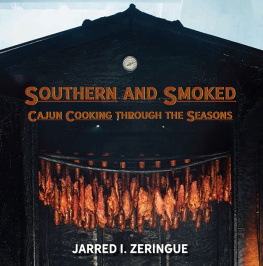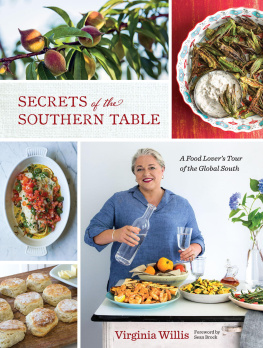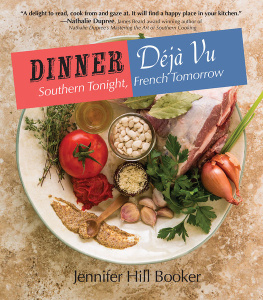Title Page
PELICAN PUBLISHING COMPANY
Gretna 2014
Copyright 2014
By Jennifer Hill Book
All rights reserved
Copyright
The word Pelican and the depiction of a pelican are
trademarks of Pelican Publishing Company, Inc.,and are
registered in the U.S. Patent and Trademark Office.
ISBN: 9781455619726
E-book ISBN: 9781455619733
Produced by Pinafore Press / Janice Shay
Food styling by Jennifer Hill Booker
Additional editing by Cameron Spencer
and Michelle Menner
Photographs on pages 63, 83, 92, and 149 were taken at the Community of Serenbe, near Newnan, GA
Printed version printed in China
Published by Pelican Publishing Company, Inc.
1000 Burmaster Street, Gretna, Louisiana 70053
Dedication
This book is dedicated with love and admiration to: Ida Belle, Bessie Lee, and LaVerne,
three of the best cooks I know; and to
Jenelle, Regine, Derrick, and Evette, my daily motivators;
and, of course, to Fifi, Erin, and Chelle
thank you for years of dishwashing, hauling boxes, and helping me fulfill my dreams.
I love you all.
Contents

Getting Here from There
Glossary
Jellies, Jams, and Preserves
Pickles, Peppers, and Hot Sauce
Fresh from the Garden
Beans, Greens, and Pot Likker
Breads
Rise and Shine
Whats for Supper?
Pies, Cakes, and Cobblers
Drinks and Cocktails
Acknowledgments
Getting Here from There
Getting Here from There
This book is inspired by my childhood on my familys farm in Charleston, Mississippi, and, later, by my Le Cordon Bleu culinary training in Paris, France. I found surprising similarities between the Southern food I grew up with and classical French cuisine, such as the use of every part of the pig to flavor soups, stews, salads, and greens; preferring to use fresh, local, farm-raised ingredients; and slow-cooking meats such as venison or rabbit with wine to bring out the flavor. These recipes are sprinkled with my memories of growing up on a farm, then living and studying in Europe.
My Southern heritage gave me a very strong foundation in growing, harvesting, and cooking, while my formal French culinary training allowed me to expand my palate and present food in a more aesthetically pleasing way. These combined experiences have added to and greatly benefited my culinary career and have contributed to the many home recipes in this book.
My path to Paris and a career as a personal chef and culinary educator was fueled by a lifelong passion for cooking. As a child, I watched as my grandmother cooked traditional Southern dishes and my mother cooked all sorts of regional and ethnic foods. I tuned in to Julia Childs television show every Sundayour version of Top Chef . I began checking out cookbooks and feeding our family in my early teens, and my sister Naomi still complains about the amount of dishes she had to wash after one of my meals!
A high school graduation trip to Paris opened my senses to the smells, flavors, and beauty of French food, and I looked for some connection to the Southern food I had grown up with and knew so well. Discovering that the French sourced their food locally and ate seasonally just as we did on the farm gave me the courage to go to culinary school to learn to cook the incredible dishes I had experienced in Europe. While studying culinary arts at Oklahoma State University, I was delighted that my teachers were French and Swiss. After graduation, I married a military man and we moved to Germany. I decided to be a personal chef there as a way to continue my culinary career while living in Germany. I cooked American food for the couples on base who missed the food back home, and taught German families how to cook American dishes. They raved about my food to friends, and I got a lot of business and an unofficial start as a culinary educator. It gave me a creative outlet for the times my husband was deployed, which was often. I began to keep a database of recipes, which led to writing many of these recipes. When we were moved to Heidelburg, I applied for a continuing education scholarship and received it. I saved all I could and applied to Le Cordon Bleu in Paris and was accepted. I remember arguing with the admissions director that I should start in the intermediate courses, but she insisted that I had to start at the beginning. Im glad I did! The lectures and demonstrations were taught in French, and by the time I left, I was fluent in the language.
There is an assumption, more often than not, that because I am a black chef I must only know how to cook Southern food, and that I have no culinary training. Neither assumption is true. Southern food has a rich history that is firmly rooted in tradition and, yes, originally cooked by blacks, both slaves and Freemen. But I did not set out to strictly be a Southern chef and do not make my living cooking only Southern food. I would, however, be remiss if I didnt acknowledge the huge influence African food has had on Southern cuisine. Okra, black- eyed peas, yamsthese all came to us from Africa. I grew up enjoying traditional Southern black dishes, such as hoe cakes, cracklin bread, hog head cheese, chicken feet, and fried squirrel (all are included in this cookbook). Although these dishes are not part of French cuisine, they are my culinary heritage, and I have attempted to refine them by making them healthier and using modern cooking techniques. Thankfully, we dont need to cook hoe cakes on a hoe heated on the open fire anymore!
Interestingly, I found that any prejudice in commercial kitchens is more about gender than color. My Paris Le Cordon Bleu instructors were especially tough on women, letting us know that they thought of us as housewives and felt we had no place in their kitchens. After a particularly tough critique, I would some- times go to the bathroom to cryI didnt want to be perceived as an emotional female, so I never let them see me cry. At the beginning of the classes, there were a large number of female American students, but almost all dropped out eventually, due in large part to the rigorous schedule.
When I graduated, I received top honors for base de cuisine , and I was deter- mined to be a woman in the kitchen, regardless of the prevailing sentiment. I live in Atlanta now, and things have changed a lot in the food world. I am proud to stand with a spectacular group of female chefs. In 2012, I had the honor of being inducted into the prestigious Atlanta chapter of Les Dames d Escoffier International (LDEI), an elite group of women in the culinary profession that includes chefs, business owners, authors, and farmers. We promote education and philanthropy for our communities. I also co-chair Green Tables, a farm and garden philanthropic initiative of LDEI. Its purpose is to provide a link between urban and rural farmers, to promote the planting of gardens in urban communities, and for schools, restaurants, and kitchen tables.
In 2004, I was hired to teach at the new Le Cordon Bleu campus in Atlanta, Georgia. Within six months, I was promoted to lead chef instructor and given my own classroom for garde manger , which means keeper of the food. I taught the traditional methods of canning, preserving, cheese and sausage making, terrines, cold soups, and salads. This teaching job led to a directorship of the culinary arts program at Grayson High School in Atlanta, which became the first accredited culinary high school program in the state of Georgia.













